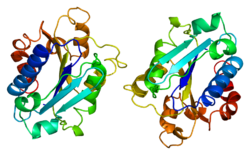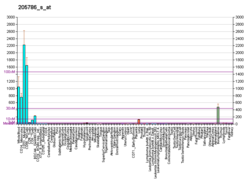| ITGAM |
|---|
 |
|
| Structures disponibles |
|---|
| PDB | Recherche d'orthologue: PDBe RCSB |
|---|
| Identifiants PDB |
|---|
1BHO, 1BHQ, 1IDN, 1IDO, 1JLM, 1M1U, 1MF7, 1N9Z, 1NA5, 2LKE, 2LKJ, 3Q3G, 3QA3, 4M76, 4XW2 |
|
|
| Identifiants |
|---|
| Aliases | ITGAM |
|---|
| IDs externes | OMIM: 120980 MGI: 96607 HomoloGene: 526 GeneCards: ITGAM |
|---|
| Position du gène (Homme) |
|---|
 | | Chr. | Chromosome 16 humain[1] |
|---|
| | Locus | 16p11.2 | Début | 31,259,967 bp[1] |
|---|
| Fin | 31,332,892 bp[1] |
|---|
|
| Position du gène (Souris) |
|---|
 | | Chr. | Chromosome 7 (souris)[2] |
|---|
| | Locus | 7|7 F3 | Début | 127,661,812 bp[2] |
|---|
| Fin | 127,717,663 bp[2] |
|---|
|
| Expression génétique |
|---|
| Bgee | | Humain | Souris (orthologue) |
|---|
| Fortement exprimé dans | - monocyte
- granulocyte
- os spongieux
- moelle osseuse
- sang
- cellule de la moelle osseuse
- rate
- appendice iléo-cæcal
- upper lobe of left lung
- Caduque basale
|
| | Fortement exprimé dans | - granulocyte
- moelle osseuse
- iléon
- Jéjunum
- rate
- dentate gyrus of hippocampal formation granule cell
- hippocampus proper
- œsophage
- striatum of neuraxis
- utérus
|
| | Plus de données d'expression de référence |
|
|---|
| BioGPS |  | | Plus de données d'expression de référence |
|
|---|
|
| Gene Ontology |
|---|
| Fonction moléculaire | - liaison ion métal
- liaison protéique
- protein heterodimerization activity
- heat shock protein binding
- amyloid-beta binding
- complement component C3b binding
- cargo receptor activity
| | Composant cellulaire | - exosome
- membrane plasmique
- surface cellulaire
- membrane
- integral component of membrane
- integrin complex
- milieu extracellulaire
- specific granule membrane
- tertiary granule membrane
- external side of plasma membrane
- integrin alphaM-beta2 complex
- plasma membrane raft
- radeau lipidique
| | Processus biologique | - ectodermal cell differentiation
- toll-like receptor 4 signaling pathway
- integrin-mediated signaling pathway
- leukocyte migration
- extracellular matrix organization
- adhésion cellulaire
- neutrophil degranulation
- microglial cell activation
- processus du système immunitaire
- endocytose à récepteur
- phagocytosis, engulfment
- cytokine-mediated signaling pathway
- positive regulation of superoxide anion generation
- positive regulation of neutrophil degranulation
- système immunitaire inné
- negative regulation of dopamine metabolic process
- positive regulation of protein targeting to membrane
- amyloid-beta clearance
- cell-cell adhesion via plasma-membrane adhesion molecules
- complement-mediated synapse pruning
- vertebrate eye-specific patterning
- positive regulation of neuron death
- positive regulation of microglial cell activation
- positive regulation of microglial cell mediated cytotoxicity
- cell surface receptor signaling pathway involved in cell-cell signaling
- positive regulation of prostaglandin-E synthase activity
- forebrain development
- apoptotic signaling pathway
- positive regulation of hippocampal neuron apoptotic process
| | Sources:Amigo / QuickGO |
|
| Orthologues |
|---|
| Espèces | Homme | Souris |
|---|
| Entrez | | |
|---|
| Ensembl | | |
|---|
| UniProt | | |
|---|
| RefSeq (mRNA) | | |
|---|
| RefSeq (protéine) | | |
|---|
| Localisation (UCSC) | Chr 16: 31.26 – 31.33 Mb | Chr 7: 127.66 – 127.72 Mb |
|---|
| Publication PubMed | [3] | [4] |
|---|
|
| Wikidata |
| Voir/Editer Humain | Voir/Editer Souris |
|

 Portail de la biologie cellulaire et moléculaire
Portail de la biologie cellulaire et moléculaire  Portail de la médecine
Portail de la médecine 


















